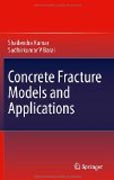
ementitious materials, rocks and fibre-reinforced composites commonly termed as quasibrittle , need a different fracture mechanics approach to model the crack propagation study because of the presence of significant size of fracture process zone ahead of the crack-tip. Recent studies show that concret e structures manifest three important stages in fracture process: crack initiation, stable crack propagation and unstable fracture or failure. F racture Mechanics concept can better explain the above various stages including the concepts of ductility, size-effect, strain softening and post-cracking behavior of concreteand concrete structures. The book presents a basic introduction on the various nonlinear concrete fracture models considering the respective fracture parameters. To this end, a thorough state-of-the-art review on various aspects of the material behavior and development of different concrete fracture models is presented. The development of cohesive crack model for standard test geometries using commonly used softening functions is shown and extensive studies on the behavior of cohesive crack fracture parameters are also carried out. The subsequent chapter contains the extensive study on the double- K and double- G fracture parameters in which some recent developments on the related fracture parameters are illustrated including introduction of weight function method to Double- K Fracture Model and formulization of size-effect behavior of the double- K fracture parameters. The application of weight function approach for determining of the K R -curve associated with cohesive stress distribution in the fracture process zone is also presented. Available test data are used to validate the new approach. Further, effect of specimen geometry, loading condition,size-effect and softening function on various fracture parameters is investigated. Towards the end, a comparative study between different fracture parameters obtained from various models is presented. " Covers all important concrete fracture models with numerical examples Is totally new and covers the latest research works carried out regarding behavior of fracture parameters of concrete Readers can have a complete understanding of fracture behavior of concrete during crack propagation Compact and concise and the results are presented in numerous figures INDICE: Foreword.- Preface.- List of Symbols and Abbreviations.- Introduction to Fracture Mechanics of Concrete.- Fracture Mechanics of Concrete – State-of-the-Art Review.- Fracture Behavior of Concrete using Cohesive Crack and Size Effect Models.- Crack Propagation Study using Double- K and Double- G Fracture Parameters.- Fracture Properties of Concrete based on the K R curve Associated with Cohesive Stress Distribution.- Comparison of Fracture Parameters of Concrete using Nonlinear Fracture Models.- Appendix. Subject index.
- ISBN: 978-3-642-16763-8
- Editorial: Springer
- Encuadernacion: Cartoné
- Páginas: 406
- Fecha Publicación: 01/02/2011
- Nº Volúmenes: 1
- Idioma: Inglés
